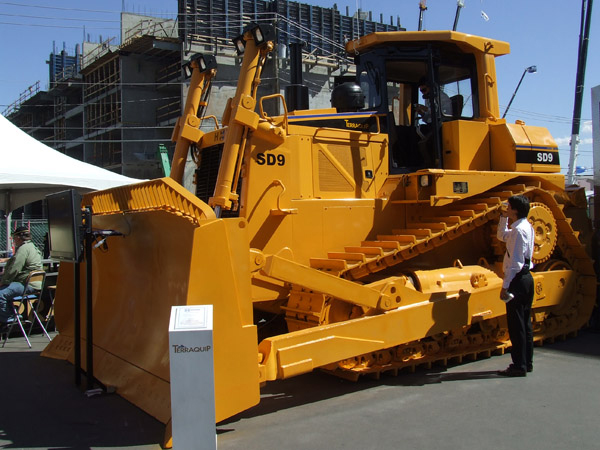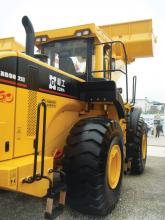David CA Phillips reports on the changing structure of the global construction equipment industry. In 2007, the year of peak historical demand and before the onset of the international financial crisis, estimated total sales of key equipment types stood at just over 1,000,000 units, valued at approximately US$100 billion. By 2009 sales had fallen to around 600,000 units valued at around $65 billion. The consequences of the global financial recession were dramatic and immediate, and remain with us today, and

Exports are seen as crucial to Chinese manufacturers, which are now targeting major international exhibitions as a way to promote their brands
David CA Phillips reports on the changing structure of the global construction equipment industry
In 2007, the year of peak historical demand and before the onset of the international financial crisis, estimated total sales of key equipment types stood at just over 1,000,000 units, valued at approximately US$100 billion. By 2009 sales had fallen to around 600,000 units valued at around $65 billion. The consequences of the global financial recession were dramatic and immediate, and remain with us today, and doubtless for ever more.In 2010 came the beginnings of a recovery, but not from the traditional markets of Europe, North America and Japan. In the golden years of the late 1990s, these three markets jointly accounted for anywhere between 50-60% of world demand. Now they combine to account for about 30% at most.
China and India are the two markets that have blossomed most in the recent past, China in particular. In 2005 China accounted for 18% of global sales; in 2010 it accounted for about 50%, and there is every sign that this proportion will grow for the foreseeable future.
During the 1980s and 1990s, the traditional markets for construction equipment, North America, Japan and Western Europe, traditionally accounted for 50% of global sales and production. These markets were active because of government investments into all aspects of infrastructure and this stimulated strong demand for a wide variety of equipment; and increasingly for impact, multipurpose machinery such as mini excavators, skid-steer loaders and telescopic handlers.
Steady, large volume growth in these traditional markets gave rise to major regional production hubs, which would supply both local demand, and feed exports to developing markets such as South America, India and China. Very importantly, the rise of these manufacturing bases gave birth to an increasingly sophisticated component supply industry located close to the source of demand. By 2000 however, this position began to change. China began a programme of unprecedented expansion, triggering the biggest and most sustained construction boom the world has ever seen.
By 2005, China's sales had increased to almost 150,000 units compared to only 36,500 in 2000. In the same period, Indian sales had grown from 4,500 units to almost 17,000 units.
The global financial crisis of 2008 continues to reverberate around the world. By the end of 2007, and for most of the next two years, demand in Europe and North America was in freefall: the global financial crisis severely curtailed the availability of financing, and depressed business confidence. The halcyon days of 2005-2007 of easily available credit had resulted in unsustainable demand and excessive production. When the bubble burst there was a massive overhang of stock throughout the supply chain. Markets collapsed by 60-80% from the peak of 2007.
In contrast, China was left almost untouched. Centrally controlled policies had denied the arrival of toxic financial assets into its economic system, and with a massive injection of emergency funding, demand for construction equipment continued to soar: from around 150,000 units in 2005, to 350,000 units in 2010. This was around three times the volume in Europe, and North America.
The forecast for global sales is bright, and the next five years' average is well above that for the period 2006-2010. But the real growth will take place in the developing markets of China and India, while expansion in Europe and North America will be pitifully slow.
The Chinese market now accounts for around 50% of global demand, and production.
North America and Europe used to account for 45-50% of world sales. But that combined percentage has now fallen to around 20-25%, a position that is unlikely to change for the foreseeable future.
European sales peaked at over 200,000 units in 2007, and bottomed out at under 70,000 units in 2009. There is a slow improvement forecast, but the next five year average will be a full 25% below that achieved in the previous five year period. Lower government investment into capital spending, largely unused equipment from the last buying spree chasing too little work, ever present stock, and lack of business confidence have contributed to a weak outlook.
All countries have been affected by the financial crisis, Greece, Ireland, Portugal and Spain in particular.
North America went into recession around 18 months before Europe, and its decline was faster and steeper. Rental is important in the US market, and when that sector takes fright the market closes down very quickly. The government's economic stimulus has had little impact on demand, which is forecast to grow slowly over the next five years. The forecast peak of demand in 2014-2015 will only represent 60% of the peak seen in 2006.
India's development is strong but its growth is slower than China. This has largely been due to its democratic traditions, land rights and bureaucracy. In the period 2004-2007 demand was showing similar rates of growth as China had done in 1998-2003, and 2007 was a particularly good year. Strong sales in the last half of 2010 and early 2011 shows that India's potential is still largely untapped.
Sales will likely double in the next five years, with the forecast average being at least twice that of the last five years. There is likely to be a future structural shift in demand from the popular backhoe loader, to more productive, efficient and profitable equipment such as crawler excavators and wheeled loaders.
But China has in five short years become the world's largest market for construction equipment, and is now the largest manufacturer of construction equipment. With sales of around 350,000 units valued at $27 billion, China is becoming the global centre of attention for manufacturers and component suppliers.
The construction equipment industry has been designated of strategic importance by the Chinese government. If the ambitious infrastructure projects are to be completed according to plan then it is crucial that the domestic industry is well equipped to meet future needs. Whilst growth of around 40% in 2010 was high, future rates of growth can be expected to remain at 5-7%, resulting in sustainable demand.
Domestic production has grown dramatically in the last five years, from around 160,000 units in 2005 to over 420,000 units in 2010. Looking ahead, China's domestic manufacturing industry will soon be able to produce around 700,000 units/year, almost equivalent to world needs.
Market demand is changing fast.
Previously, Chinese equipment sales were dominated by cheap and old technology wheeled loaders. But crawler excavators have grown rapidly in popularity, with sales peaking at 140,000 units in 2010. Domestic excavator sales are likely to peak at around 250,000- 300,000 units/year by 2015: it is sobering to think that global sales of excavators (including China) in 2010, was 210,000.
No longer is China the source of cheap and inferior products. Many domestic manufacturers have made enormous strides in developing their own technologies, manufacturing processes and distribution networks. They, like the government, are determined that China will become a global powerhouse, and increasingly the world's source of construction equipment.
But it is not only the domestic manufacturers that are forging ahead in China.
International OEMs began investing in Chinese production in the early 1990s, and now almost every major manufacturer has significant local capacity to serve China's domestic demand, and exports in the future. They have tended to favour production of excavators in the past but have recently been widening output to include wheeled loaders, mobile cranes, mini excavators and road making equipment. Favorable government incentives and easy access to labour and components have combined to make China an attractive place to do business.
Increasingly, production capacity is being moved closer to the main markets of demand.
In contrast, European and North American production, so long steady at 150,000-200,000 units/year, slumped to a fraction of that in 2009, while a feeble recovery was seen in 2010.
The outlook is for Chinese production to continue to grow and it will increasingly act as an international source of equipment supplied by domestic and international manufacturers.
International component manufacturers will be attracted to manufacture in China.
International OEMs want to have a standard product, and to achieve this they need to have their supply chain increasingly standardised, and demand that their chosen partners also have Chinese manufacturing bases.
China's domestic component supply base, especially for key products such as diesel engines, hydraulic, axles and transmissions, has been of consistently low quality. They were good enough to meet the demands of local suppliers a decade ago, but not now. Domestic equipment manufacturers are increasingly placing a premium on quality, and as a result they turn to international component suppliers, especially for their crawler excavators, and for machines that are destined for exports.
It is evident that the traditional markets of Europe and North America will never recover to the heights of 2005-2007. These inflated levels of demand and the subsequent collapse have forced all manufacturers and component suppliers to reassess future business plans.
With China becoming the centre of the universe for construction equipment, accounting for 50% of global sales and production there is a compelling argument that says that the industry's centre of gravity has now moved from the West to the East.
Author *David CA Phillips is managing director of






